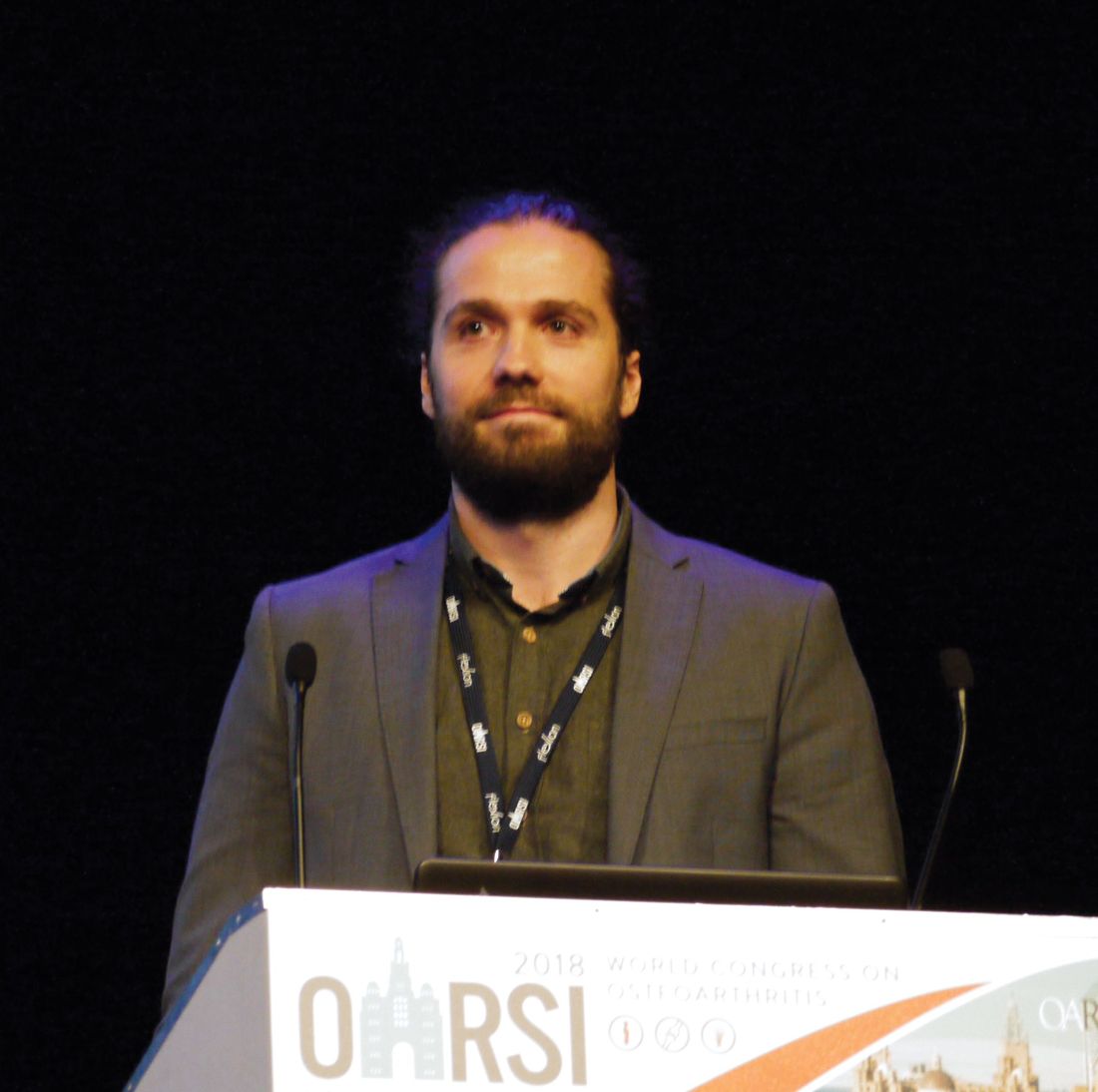User login
LIVERPOOL, ENGLAND – according to data from the Good Life with osteoArthritis in Denmark (GLA:D®) Registry.
Clear differences in the clinical presentation can be observed between patients with knee OA who have and have not had a previous knee injury, researcher Paetur Mikal Holm reported at the World Congress on Osteoarthritis.
“These differences include being younger, being a male, having a lower BMI [body mass index], and being more physically active; also, we see reduced quality of life, longer symptom duration, and widespread pain” said Mr. Holm, a PhD fellow in the department of sports science and clinical biomechanics, musculoskeletal function, and physiotherapy at the University of Southern Denmark in Odense. “The last two characteristics in particular – widespread pain and symptom duration – may have an important impact on treatment,” he added.
“People with a prior knee injury have a 25% higher probability of having widespread pain compared to people without a prior knee injury,” Mr. Holm and his associates said in their abstract. This could mean that specialized interventions are needed to address pain in these individuals, especially when there is a long duration of symptoms.
Disease characteristics and trajectories in knee osteoarthritis are highly variable, Mr. Holm observed, and there are multiple phenotypes already reported. Posttraumatic knee OA is one of these phenotypes, but, until now, their clinical characteristics were poorly understood.
A cross-sectional study was performed using baseline data on 5,477 individuals enrolled in the GLA:D® Registry, 91% of whom had radiographic knee OA. These patients were divided into two groups based on whether they did (n = 2,440) or did not (n = 3,037) self-report a prior knee injury. This is one of the limitations of the study, Mr. Holm acknowledged. There was no specific investigation of what the prior knee injury actually was.
However, results clearly showed a significant (P less than .05) difference between the two groups. For example, the mean age of those with a prior knee injury was 64 years, whereas those without were about 65 years old (odds ratio, 0.99; 95% confidence interval, 0.98-0.99). About 29% of those with a previous knee injury were men, versus roughly 25% of those without (OR, 1.28; 95% CI, 1.12-1.46). Widespread pain was present in about 45% and 38%, respectively, for those with and without a prior knee injury (OR, 1.25; 95% CI, 1.11-1.40), and the mean duration of symptoms was 60 versus 35 months (OR, 1.05; 95% CI, 1.04-1.06). Those who reported exercising 2-4 days a week had an OR of 1.30 (95% CI, 1.05-1.59).
“Being a clinician, to me it is a worry to see that these people are young and have had symptoms for a long time,” coauthor Ewa M. Roos, PT, PhD, said at the congress, which was sponsored by the Osteoarthritis Research Society International.
“Here is a group of people that we don’t necessarily think about as athletes, these are people with osteoarthritis. They are seen in primary care, but maybe we don’t think about them as osteoarthritis patients at a younger age, but this is a group that we need to be very careful to recognize,” added Dr. Roos, also of University of Southern Denmark. She cochaired the session where the findings were presented.
The GLA:D® Registry is funded by various sources including the Danish Rheumatism Association, Naestved-Slagelse-Ringsted Hospitals, Region Zealand, and the Danish Physiotherapy Association. Dr. Holm had no conflicts of interest.
SOURCE: Holm PM et al. Osteoarthr Cartil. 2018:26(1):S56.OARSI 2018 Abstract 84.
LIVERPOOL, ENGLAND – according to data from the Good Life with osteoArthritis in Denmark (GLA:D®) Registry.
Clear differences in the clinical presentation can be observed between patients with knee OA who have and have not had a previous knee injury, researcher Paetur Mikal Holm reported at the World Congress on Osteoarthritis.
“These differences include being younger, being a male, having a lower BMI [body mass index], and being more physically active; also, we see reduced quality of life, longer symptom duration, and widespread pain” said Mr. Holm, a PhD fellow in the department of sports science and clinical biomechanics, musculoskeletal function, and physiotherapy at the University of Southern Denmark in Odense. “The last two characteristics in particular – widespread pain and symptom duration – may have an important impact on treatment,” he added.
“People with a prior knee injury have a 25% higher probability of having widespread pain compared to people without a prior knee injury,” Mr. Holm and his associates said in their abstract. This could mean that specialized interventions are needed to address pain in these individuals, especially when there is a long duration of symptoms.
Disease characteristics and trajectories in knee osteoarthritis are highly variable, Mr. Holm observed, and there are multiple phenotypes already reported. Posttraumatic knee OA is one of these phenotypes, but, until now, their clinical characteristics were poorly understood.
A cross-sectional study was performed using baseline data on 5,477 individuals enrolled in the GLA:D® Registry, 91% of whom had radiographic knee OA. These patients were divided into two groups based on whether they did (n = 2,440) or did not (n = 3,037) self-report a prior knee injury. This is one of the limitations of the study, Mr. Holm acknowledged. There was no specific investigation of what the prior knee injury actually was.
However, results clearly showed a significant (P less than .05) difference between the two groups. For example, the mean age of those with a prior knee injury was 64 years, whereas those without were about 65 years old (odds ratio, 0.99; 95% confidence interval, 0.98-0.99). About 29% of those with a previous knee injury were men, versus roughly 25% of those without (OR, 1.28; 95% CI, 1.12-1.46). Widespread pain was present in about 45% and 38%, respectively, for those with and without a prior knee injury (OR, 1.25; 95% CI, 1.11-1.40), and the mean duration of symptoms was 60 versus 35 months (OR, 1.05; 95% CI, 1.04-1.06). Those who reported exercising 2-4 days a week had an OR of 1.30 (95% CI, 1.05-1.59).
“Being a clinician, to me it is a worry to see that these people are young and have had symptoms for a long time,” coauthor Ewa M. Roos, PT, PhD, said at the congress, which was sponsored by the Osteoarthritis Research Society International.
“Here is a group of people that we don’t necessarily think about as athletes, these are people with osteoarthritis. They are seen in primary care, but maybe we don’t think about them as osteoarthritis patients at a younger age, but this is a group that we need to be very careful to recognize,” added Dr. Roos, also of University of Southern Denmark. She cochaired the session where the findings were presented.
The GLA:D® Registry is funded by various sources including the Danish Rheumatism Association, Naestved-Slagelse-Ringsted Hospitals, Region Zealand, and the Danish Physiotherapy Association. Dr. Holm had no conflicts of interest.
SOURCE: Holm PM et al. Osteoarthr Cartil. 2018:26(1):S56.OARSI 2018 Abstract 84.
LIVERPOOL, ENGLAND – according to data from the Good Life with osteoArthritis in Denmark (GLA:D®) Registry.
Clear differences in the clinical presentation can be observed between patients with knee OA who have and have not had a previous knee injury, researcher Paetur Mikal Holm reported at the World Congress on Osteoarthritis.
“These differences include being younger, being a male, having a lower BMI [body mass index], and being more physically active; also, we see reduced quality of life, longer symptom duration, and widespread pain” said Mr. Holm, a PhD fellow in the department of sports science and clinical biomechanics, musculoskeletal function, and physiotherapy at the University of Southern Denmark in Odense. “The last two characteristics in particular – widespread pain and symptom duration – may have an important impact on treatment,” he added.
“People with a prior knee injury have a 25% higher probability of having widespread pain compared to people without a prior knee injury,” Mr. Holm and his associates said in their abstract. This could mean that specialized interventions are needed to address pain in these individuals, especially when there is a long duration of symptoms.
Disease characteristics and trajectories in knee osteoarthritis are highly variable, Mr. Holm observed, and there are multiple phenotypes already reported. Posttraumatic knee OA is one of these phenotypes, but, until now, their clinical characteristics were poorly understood.
A cross-sectional study was performed using baseline data on 5,477 individuals enrolled in the GLA:D® Registry, 91% of whom had radiographic knee OA. These patients were divided into two groups based on whether they did (n = 2,440) or did not (n = 3,037) self-report a prior knee injury. This is one of the limitations of the study, Mr. Holm acknowledged. There was no specific investigation of what the prior knee injury actually was.
However, results clearly showed a significant (P less than .05) difference between the two groups. For example, the mean age of those with a prior knee injury was 64 years, whereas those without were about 65 years old (odds ratio, 0.99; 95% confidence interval, 0.98-0.99). About 29% of those with a previous knee injury were men, versus roughly 25% of those without (OR, 1.28; 95% CI, 1.12-1.46). Widespread pain was present in about 45% and 38%, respectively, for those with and without a prior knee injury (OR, 1.25; 95% CI, 1.11-1.40), and the mean duration of symptoms was 60 versus 35 months (OR, 1.05; 95% CI, 1.04-1.06). Those who reported exercising 2-4 days a week had an OR of 1.30 (95% CI, 1.05-1.59).
“Being a clinician, to me it is a worry to see that these people are young and have had symptoms for a long time,” coauthor Ewa M. Roos, PT, PhD, said at the congress, which was sponsored by the Osteoarthritis Research Society International.
“Here is a group of people that we don’t necessarily think about as athletes, these are people with osteoarthritis. They are seen in primary care, but maybe we don’t think about them as osteoarthritis patients at a younger age, but this is a group that we need to be very careful to recognize,” added Dr. Roos, also of University of Southern Denmark. She cochaired the session where the findings were presented.
The GLA:D® Registry is funded by various sources including the Danish Rheumatism Association, Naestved-Slagelse-Ringsted Hospitals, Region Zealand, and the Danish Physiotherapy Association. Dr. Holm had no conflicts of interest.
SOURCE: Holm PM et al. Osteoarthr Cartil. 2018:26(1):S56.OARSI 2018 Abstract 84.
REPORTING FROM OARSI 2018
Key clinical point: People with posttraumatic knee osteoarthritis are a distinct subgroup of patients that might be underrecognized.
Major finding: Widespread pain was present in about 45% and 38%, respectively, of those with and without a prior knee injury (OR, 1.25, 95% CI, 1.11-1.40).
Study details: Cross-sectional study of 5,477 patients enrolled in the Good Life with osteoArthritis in Denmark (GLA:D®) Registry.
Disclosures: The GLA:D® Registry is funded by various sources including the Danish Rheumatism Association, Naestved-Slagelse-Ringsted Hospitals, Region Zealand, and the Danish Physiotherapy Association. The presenting author, Dr. Paetur Mikal Holm, had no conflicts of interest.
Source: Holm PM et al. Osteoarthr Cartil. 2018:26(1):S56. Abstract 84.

